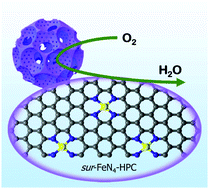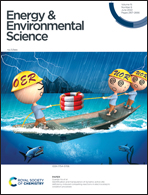Highly accessible and dense surface single metal FeN4 active sites for promoting the oxygen reduction reaction†
Abstract
Single iron atom and nitrogen-codoped carbon (Fe–N–C) electrocatalysts, which have great potential to catalyze the kinetically sluggish oxygen reduction reaction (ORR), have been recognized as the most promising alternatives to the precious metal platinum. Unfortunately, the ORR properties of the existing Fe–N–C catalysts are significantly hampered by the inferior accessibility and intrinsic activity of FeN4 moieties. Here, we constructed densely exposed surface FeN4 moieties on a hierarchically porous carbon (sur-FeN4-HPC) by Fe ion anchoring and a subsequent pyrolysis strategy using the nitrogen-doped hierarchically porous carbon (NHPC) as the scaffold. The high surface area of the NHPC with abundant surface Fe anchoring sites enabled the successful fabrication of densely accessible FeN4 active moieties (34.7 × 1019 sites g−1) on sur-FeN4-HPC. First-principles calculations further suggested that the edge effect could regulate the electronic structure of the single Fe site, hence promoting the intrinsic ORR activity of the FeN4 moiety. As a result, the sur-FeN4-HPC electrocatalyst exhibited excellent ORR activity in acidic media with a high half-wave potential of 0.83 V (vs. the reversible hydrogen electrode). We further examined sur-FeN4-HPC as a cathode catalyst in proton exchange membrane fuel cells (PEMFCs). The membrane electrode assembly delivered a high current density of 24.2 mA cm−2 at 0.9 ViR-free (internal resistance-compensated voltage) under 1.0 bar O2 and a maximum peak power density of 0.412 W cm−2 under 1.0 bar air. Importantly, the catalyst demonstrated promising durability during 30 000 voltage cycles under harsh H2 and air conditions. The PEMFC performance of sur-FeN4-HPC outperforms those of the previously reported Fe–N–C electrocatalysts. The engineering of highly accessible and dense surface FeN4 sites on sur-FeN4-HPC offers a fruitful pathway for designing high-performance electrocatalysts for different electrochemical processes.



 Please wait while we load your content...
Please wait while we load your content...